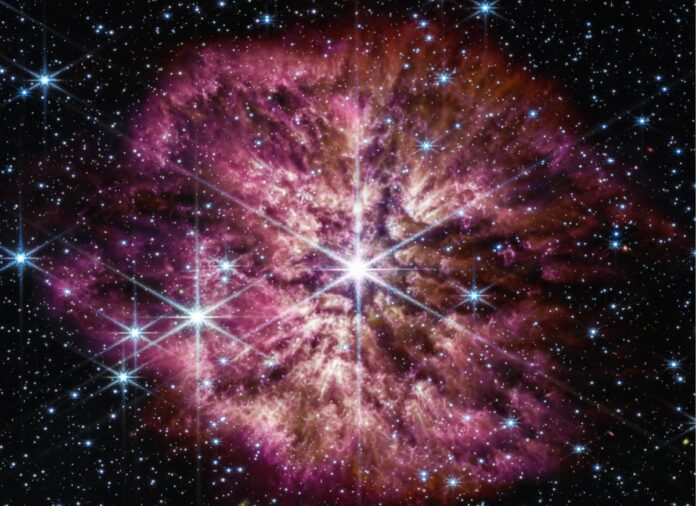NASA’s James Webb Space Telescope (JWST) has just given us some gorgeous views of a giant star’s dying days.
On Tuesday (March 14), NASA released JWST images of WR 124, a rare Wolf-Rayet star that lies about 15,000 light-years from Earth, in the constellation Sagittarius.
“Massive stars race through their life cycles, and only some of them go through a brief Wolf-Rayet phase before going supernova, making Webb’s detailed observations of this rare phase valuable to astronomers,” NASA officials wrote in a description of the images (opens in new tab), which JWST snapped in June 2022, just after becoming operational.
“Wolf-Rayet stars are in the process of casting off their outer layers, resulting in their characteristic halos of gas and dust,” agency officials added.
Related: 12 amazing James Webb Space Telescope discoveries
WR 124 is about 30 times more massive than our sun and has ejected more than 10 solar masses’ worth of gas and dust into space to date, NASA officials said. All that dust, banal though it may sound, is extremely interesting to astronomers.
“Dust is integral to the workings of the universe: It shelters forming stars, gathers together to help form planets, and serves as a platform for molecules to form and clump together — including the building blocks of life on Earth,” NASA officials wrote in the image description. “Despite the many essential roles that dust plays, there is still more dust in the universe than astronomers’ current dust-formation theories can explain.”
JWST’s observations could shed light on this mysterious “dust budget surplus,” they added. That’s because cosmic dust is best studied in infrared wavelengths, the type of light that JWST is optimized to observe.
“Before Webb, dust-loving astronomers simply did not have enough detailed information to explore questions of dust production in environments like WR 124, and whether the dust grains were large and bountiful enough to survive the supernova and become a significant contribution to the overall dust budget,” NASA officials wrote. “Now those questions can be investigated with real data.”
JWST launched atop a European Ariane 5 rocket from French Guiana on Dec. 25, 2021. The $10 billion observatory then journeyed toward the Earth-sun Lagrange Point 2, a gravitationally stable spot in space about 930,000 miles (1.5 million kilometers) from our planet.
Along the way to L2, which it reached in late January 2022, JWST unfolded its huge sunshield and multi-segment primary mirror, acing a complex deployment sequence that had mission team members, scientists and space fans around the world holding their breath.
After a lengthy series of checkouts, the mission began its science campaign in June 2022, and NASA released the first JWST imagery to the public a month later. The telescope is now conducting a wide range of potentially transformational observations, from peering at some of the universe’s first stars and galaxies to investigating the composition of nearby exoplanet atmospheres.
Mike Wall is the author of “Out There (opens in new tab)” (Grand Central Publishing, 2018; illustrated by Karl Tate), a book about the search for alien life. Follow him on Twitter @michaeldwall (opens in new tab). Follow us on Twitter @Spacedotcom (opens in new tab) or on Facebook (opens in new tab).

